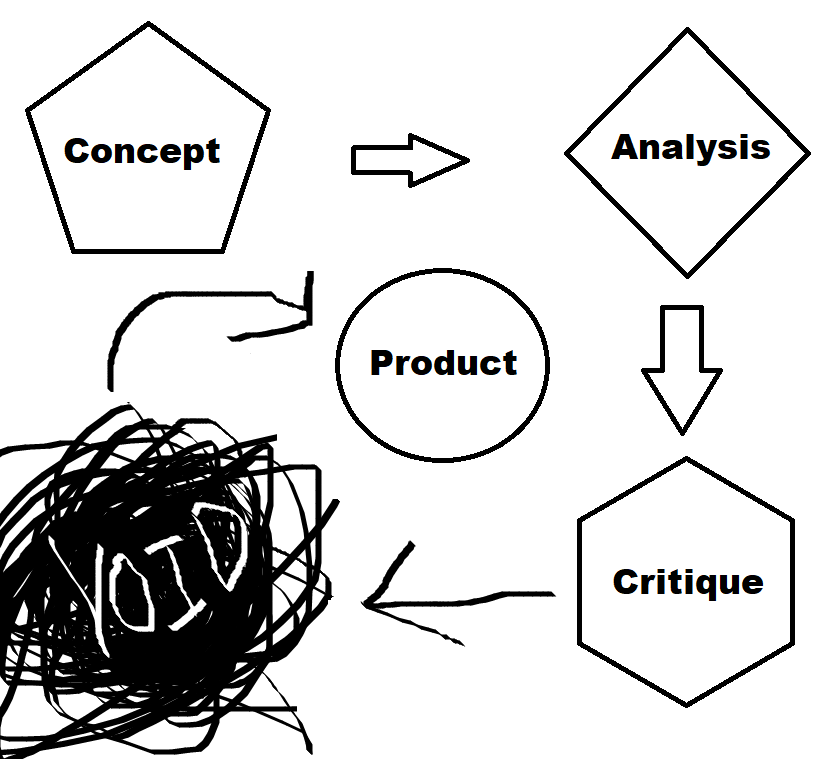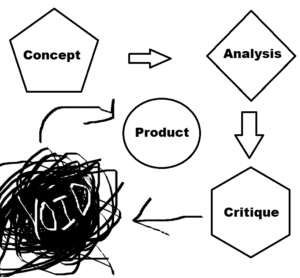
Corporate Structure
The office building has four floors.
The first floor is where the creatives conceptualize, write, illustrate, and film ads. The space is electric, energized by a collaborative group of dynamic professionals and visionary artists, etc. Ideas are developed in an atmosphere of fierce yet collegial competition. Ads that sell products die a quick death. Ads that expose their products’ souls are refined, elevated, polished to a blinding sheen, and unleashed upon the world, where they reveal deep truths, transform the global conversation, and so on.
Really, nothing distinguishes the first floor from the offices of any generic advertising firm. Similar work has been done better and worse. Occasionally, the corporation’s street team devises pranks that go viral. More often, adblockers consign their five-second videos to oblivion.
On the second floor, a group of analysts pours through the first floor’s advertisements, conversations, conflicts, and behavior. Economists, technology experts, and social psychologists analyze data, following creatives’ movements from the minute they sit at their desks to the second they walk out the door and frown at the sight of the traffic-packed street.
Amidst the mass of ironic social media posts, emails to college friends, jockeying for status, conspicuously shallow creative tumult, and corporate-mandated brainstorming sessions, these analysts discover larger patterns. They intuit which inescapable technologies teeter on the brink of obsolescence, which color combinations are about to come into vogue, and predict sudden evolutionary bursts that will send swarms of once-manageable pests out of the sewers and into blocks of apartment buildings.
By combining the talents of a carefully curated group of hyper-competitive businesspeople and trend-sensitive creatives, then combing through their obsessions, habits, and occasional productions, the moment just past the present is revealed in incredibly rich detail. Fewer young people will buy cars. Before its roof is secured, a certain skyscraper will become a suicide mecca for a city’s self-aggrandizing depressives. Music won’t matter anymore.
While slightly more interesting than the first floor, the second is simply a more focused, efficient, and thorough version of the work innumerable data-collecting businesses do twenty-four hours a day. It’s fine-tuned and impressive, but it doesn’t deliver the core of the corporation’s revenue.
After the first floor’s creatives lose their talent, they’re moved to the third floor. Eventually, it happens to all of them.
The writers’ adjectives lose their pop. The street teams’ pranks fall flat. The illustrators’ designs become irrelevant. The gift they were given disappears. Their compulsion to self-identify as artists fades with late-blooming maturity. One morning, they leave the nostalgic comforts of their home, filled with music from their college days and posters from their childhoods, and walk onto a street where they suddenly realize they recognize nothing, where the revolutionary styles of their teenage years have been ironically appropriated by mobs of red-eyed and pock-marked adolescents.
Their work no longer reflects the corporation’s youthful and innovative brand, so they’re assigned to their new desks. Installed on the third floor, they receive the second floor’s analysis and summarize the data in memos, reports, and presentations.
Without any technical background or artistic talent, the ex-creative’s summaries are mangled misinterpretations of the second floor’s conclusions. Corporate structures that break down and merge into hyper-individualized units of trans-national cooperation become hard work and elbow grease. Movies that were supposed to become shorter and narratively simpler are warped into the first two installments of the Godfather trilogy. Any changes in the way humans interpret sound inevitably devolves into guitar-based garage rock. Food forged from asteroid-mined elements becomes grandma’s hot apple pie left to cool on the windowsill. Both unable and unwilling to understand the information they’re given, the former creatives twist it until it’s something they recognize, something they can explain. Terrified of the new, with its self-immolating cars and un-hollow homes, they frantically reinterpret it as the familiar, sculpting and molding this strange present until it fits into the shape of their past.
The corporation only makes money on these summaries after they’re sent to the fourth floor, which is not above the third floor. Instead, it’s somewhere in one of the neighborhoods near the office building or in another, more distant neighborhood. The fourth floor produces the vast majority of the corporation’s profits.
There, the third floor’s work is delivered to clients. A small group of CEOs, influencers, and business gurus pay astronomical prices for the third floor’s reports. These are the men and women who revolutionized the way we dress, making jeans a thing of the past and wrapping our legs in tentacles of high-performance superfluids. They told us to give up our smartphones, disrupting human curiosity and society’s need for knowledge. Without them, we never would have realized that the universe’s matter was built by the void and the physical world has no real presence.
They fought, pioneered, and disrupted until, one afternoon at 5 pm, while their least productive employees headed home for the evening, they looked out of their corner office window and gazed at a hometown that no longer felt like home.
In that moment, they realized that their work had gone too far. They had hunted culture and hung its taxidermied head on their trophy wall, but now, that dead beast’s cousin, vicious, hungry, and deranged, prowled their city’s streets. This new monster, adapted to thrive amongst the technologies they had built themselves, hid in the shadows, searching the wind for their scent.
When these distinguished entrepreneurs receive the third floor’s reports, they grip the papers with sweaty and shaking palms and dig into the pages.
Their hearts race, not because they’ve bought innovative advertising strategies, competitive forecasts, or market analysis. Traditional, conservative companies sell those products at cheaper rates. What the third floor’s ex-creatives have written is something far more valuable.
In these texts, the thought-leaders see a world that’s recognizably the one they created, a society incredibly similar to the one they transformed, a human identity that looks almost exactly like the one they re-built, yet entirely unchanged from the culture in which they were born, before they made their first breakthroughs and innovated their way into the elite. The present these papers describe is so close to the real thing, so near the actual fact, they can actually convince themselves it’s true.
The third floor tells the executives stories in which the new is just a pleasant version of the old, where nothing will ever really be different than it was before, back when they were children playing with their cousins beneath the Thanksgiving dinner table. It shows them a reality where all the change they wrought changed nothing at all.
For the billionaires and innovators, it’s comforting. For the corporation, it’s a reliably strong profit center.
This story originally appeared in the second issue of Angry Old Man: A Magazine of Experimental Art & Poetry. That version is no longer available online.
